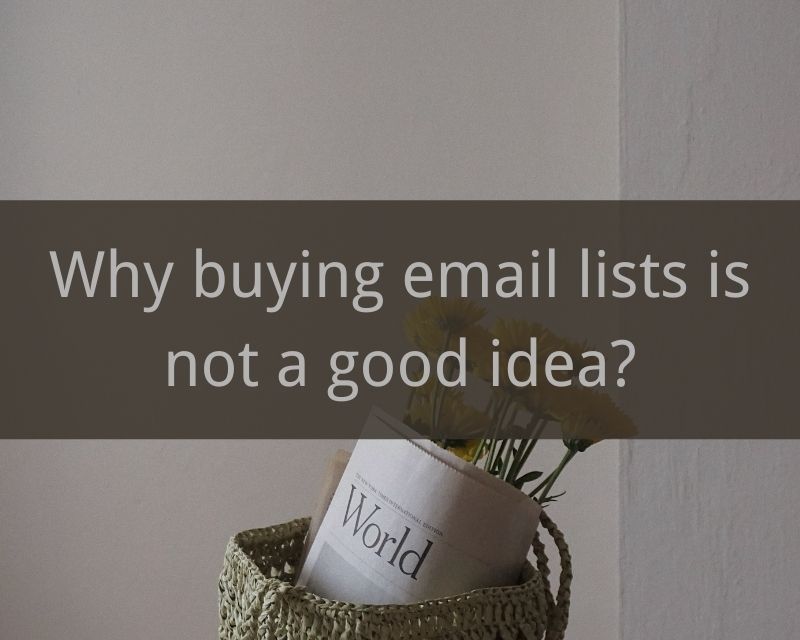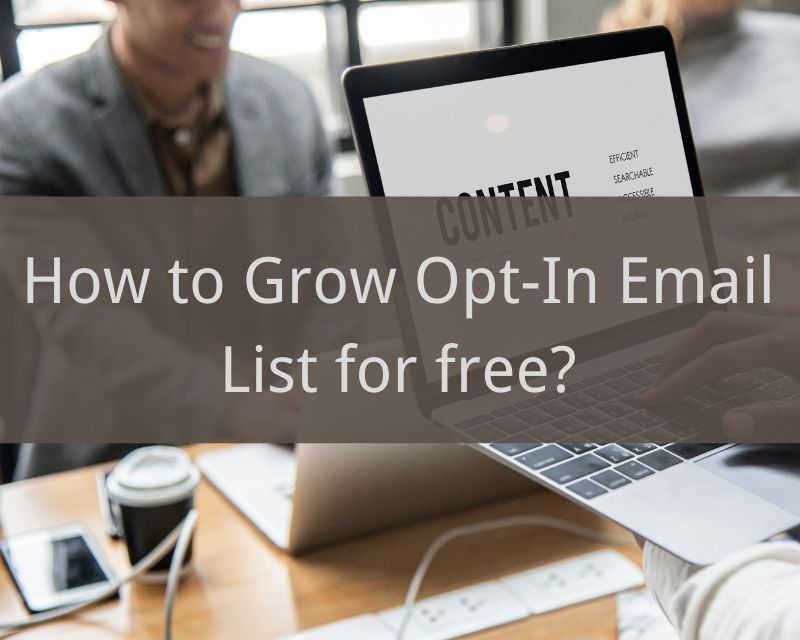You need people who you can email, and you need them quickly. Oh, and if you can get them fairly inexpensively, that’s great too.
This is the mindset that many marketers find themselves in when they are on the phone with list buying companies. We need new people to email to support our sales team. However, taking action in such desperate times can cause them more harm than good.
Yes, thousands of contacts are just a credit card swipe away, but your email marketing program. A key part of a comprehensive inbound marketing strategy – can be severely impacted. Curious why buying an email list is the kiss of death for legitimate email marketers? Read on.
Plus, we’ll give you a clean and effective way to build your email marketing list, not just buy one.
Methods of Acquiring an Email List
Before we discuss the pitfalls of buying email addresses, let’s review the three ways marketers are currently able to get access to their email lists.
#1 Purchase an email list.
You work with a list provider to find and purchase a list of names and email addresses based on demographic and/or psychographic information. For example, you might purchase a list of 50,000 names and email addresses of people who live in Minnesota and do not have children. There are several sustainable ways to use email marketing to grow your business. This is not one of them.
#2 Rent an email list.
Again, working with a list provider, you identify a portion of people’s emails — but you never actually own the list. Therefore, you can’t see the email addresses of the people you’re emailing. So you have to work with a provider to send your emails.
#3 Have an opt-in email list.
Someone volunteers to give you their email address online or in person so you can send them an email. They can pick and choose certain types of email content they would like to receive, such as specifically asking to receive email alerts when new blog posts are published. Opt-in email addresses are the result of earning the interest and trust of your contacts because they think you have something valuable to say.
When it comes to rented or purchased lists, you may encounter vendors or marketers who say, “This email list is completely opt-in!”. This means that someone on the list has opted in at some point to receive email communications from someone – such as a list provider – by filling out a form or checking a box to receive more content from that provider.
However, “opting-in” to a list does not mean that the email recipient has opted in to receive email communications from your business. This is a key distinction, and the next section of this post will go into more detail about why this type of “opt-in email list” (which should be read in quotes) is not a good idea for your email marketing program.
Why You Shouldn’t Buy Email Lists
1. You’ll violate the rules of consent under GDPR.
Most email marketers around the world are required by law to allow recipients to opt-out of emails they no longer want to receive. Contacts must be able to do this directly in the email message. The General Data Protection Regulation (GDPR), a European data privacy bill that took effect in May 2018, doubles down on the opt-in aspect of this relationship. And purchased email lists simply don’t fit the bill.
The GDPR modifies many aspects of how digital marketers use customer data throughout Europe – on websites, on social media, and via email. You don’t even have to work in Europe to be governed by the act; if your recipients live in Europe, they are protected by the GDPR.
With GDPR now governing all email communications throughout Europe, adding an opt-out option to your email templates is no longer an issue. Under the Act, you must have the explicit consent of your contacts to send them emails. In this case, explicitly means that a person must click the checkbox to opt-in to email subscriptions, not pre-select it when they see it on your website. And when you buy your email list, the person on it hasn’t gotten that option yet. You’re not GDPR compliant until you send your first email.
Want some non-legal reasons to avoid buying an email list? We have those reasons, too, below.
2. Reputable email marketing services don’t let you send emails to lists you’ve bought.
If you use email marketing software now or plan to in the future, you will find reputable companies that will insist that you use an opt-in email list. You might say, “I’ll just use an email marketing provider that is not reputable.”
Alas, ESPs on shared IP addresses that don’t require customers to use opt-in email lists usually have poor deliverability rates. Why? An inappropriate list of email addresses for one customer can poison the deliverability rate of other customers on that shared IP address. If you want your emails to actually make it to the inbox, you need to hitch your wagon to the bright side of the email marketing force.
3. Good email address lists aren’t for sale.
Unless your company is undergoing a merger or acquisition, you will not come across a quality email list that you can buy. If it’s for sale, that means the email addresses on it have been deemed unresponsive or ineligible for marketing promotions.
While the email addresses bought may have been valuable at one time, they’ve probably been scammed. Otherwise, they would still be in the hands of the company selling them. Think about it. Would you sell or share the email addresses of people who voluntarily opted in to receive your emails?
4. People on a purchased or rented list don’t actually know you.
I’ve mentioned this before, but it’s worth discussing this in a little more detail. Rented and purchased lists are sometimes scraped from other sites. And I think we can all agree that this is a dirty way to get email marketing contacts.
But let’s say the email addresses you want to purchase are not scraped from other sites but obtained legally. Email list buying and leasing companies may brag that these lists are “opt-in”. Sounds good, right?
This is not the case. The email addresses that are part of an “opt-in” list have opted in to receive emails from, say, the list buying company – not your company. Even if the opt-in process includes language such as, “Opt-in to receive messages from us. Or offers from other companies we think you might like,” the truth is that the recipient doesn’t remember having a specific relationship with you. This makes it very likely that the recipient will mark you as “spam” when you arrive in their inbox. Hey, if they don’t know you and don’t remember opting into your communications ……. Can you blame them?
This brings us to the next question.
5. You’ll harm your email deliverability and IP reputation.
Did you know that there are organizations dedicated to fighting spam? Thank goodness for that, right? They’ve created a little thing called a honeypot, which is an email address that is implanted to identify the sender as spam when harvesting and sending emails. Similarly, something called a spam trap can be created to identify spam campaigns; these traps are set when an email address gets a hard bounce because it’s expired or no longer valid, but still receives consistent traffic. Something fishy, right?
As a result, the email address becomes a spam trap that no longer returns hard bounce notifications, but accepts emails and reports the sender as spam.
If you purchase a list, you have no way to confirm how often these email addresses are sent. Or whether the email addresses on that list have been scrubbed for hard bounces to prevent identifying you as spam, or where these email addresses are coming from.
6. You can come across as annoying.
What do you think when you get an email in your inbox from a company you’ve never heard of? I’ll bet it’s not a company you want to buy from or work for.
If someone hasn’t asked to hear from you yet, that doesn’t mean they won’t want to hear from you later. It’s your job to prove to them. Through useful content and valuable offers – that they should stay informed about your company through email. If you impose your email content on anyone too soon, even if you know in your bones that they’re a good fit for your product or service, you risk losing their trust and their future business.
In conclusion
Buying an email list from some platforms or agents is not a good idea. It can do harm to your brand reputation and may lose more leads. The best way to collect an email list is to set up an opt-in subscription. Customers join your list actively and positively. Then, when they received newsletters from your side, they won’t be thrown out to the trash or spam filters.


